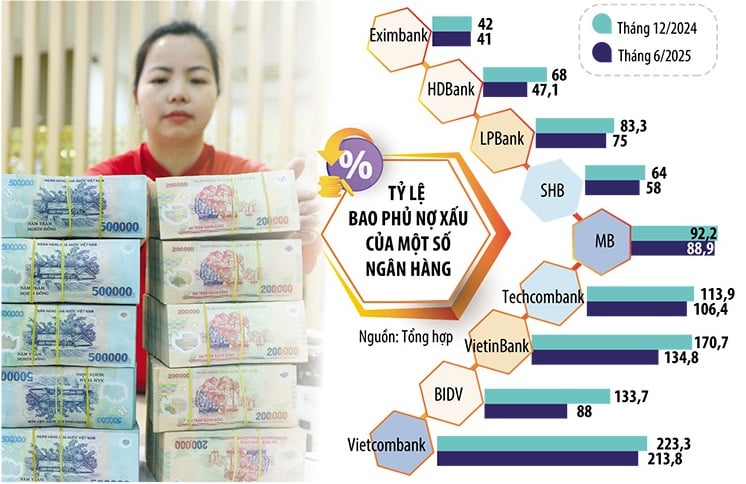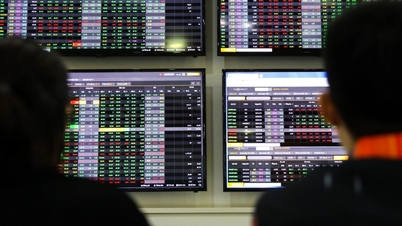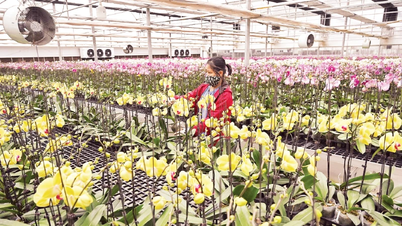 |
Many banks' risk buffers have fallen sharply.
The financial report for the second quarter of 2025 shows that 85% of banks listed on the stock exchange recorded positive profit growth, more than half of banks had double-digit profit growth. In particular, many banks recorded a profit increase of 30-80%, such asSHB , PGBank, Sacombank, VietinBank, SeABank...
However, financial reports also show that to maintain high profit growth in the first half of this year, many banks have had to accept reducing their risk buffers.
Leading in terms of bad debt coverage ratio is the group of state-owned commercial banks (“Big 4”), but among them, only Agribank increased its bad debt coverage ratio in the first half of this year. The separate mid-year financial report shows that, as of the end of June 2025, Agribank's bad debt coverage was 148.6%, an increase of 16.8% compared to the beginning of the year.
Meanwhile, BIDV 's bad debt coverage (according to the consolidated financial report) is only 88%, a sharp decrease compared to 133.7% at the end of 2024 and 96.8% at the end of the first quarter of 2025. BIDV's total bad debt increased by 49% in the first 6 months of 2025, up to VND 43,140 billion, while the provision increased by only 9.5%, causing bad debt coverage to decrease sharply.
Although Vietcombank is still the champion in terms of bad debt coverage across the system (213.8%), it has also witnessed a decline compared to the end of last year (223.3%). At VietinBank, bad debt coverage is only 134.8%, instead of 170.7% at the end of last year.
Most private joint stock commercial banks are also in a state of gradually decreasing risk buffers, currently only a few banks have a bad debt coverage ratio of over 100%.
Specifically, at MB, the bad debt coverage ratio at the end of June 2025 was only 88.9%, instead of 92.3% at the end of 2024. At HDBank, bad debt coverage was only 47.1%, much lower than the level of nearly 68% at the end of last year. At SHB, bad debt coverage is currently 58%, while at the end of last year it was nearly 64%. Similarly, LPBank also reduced the bad debt coverage ratio from 83.3% at the end of last year to 75% at the end of the second quarter of 2025. Some banks with low bad debt coverage ratios are VIB (37.16%), NamABank (39%), EximBank (41%), MSB (55.5%)...
From 2022 to now, the bad debt coverage of the entire banking system has decreased sharply. If in the third quarter of 2022, the bad debt coverage was 143.2%, then by the third quarter of 2023 it had dropped below 100% and at the end of the first quarter of 2025 it was only about 80%.
Still need to improve backup capacity
It is understandable that commercial banks accept to reduce provisions to prioritize growth, when the pressure on profit growth from shareholders is very high. In addition, the current economic context also has many differences compared to the previous period, making the reduction of provisioning ratio a trend in the past few years.
The Circular for the first time provides regulations on capital buffers, including capital conservation buffer (CCB), countercyclical capital buffer (CCyB) and capital buffer for systemically important commercial banks. This is an important premise for the roadmap to eliminate the State Bank's credit limit allocation mechanism, and at the same time move towards implementing Basel III.
According to experts, in the period 2020-2022, bad debts swelled due to the impact of Covid-19, many banks had to restructure debts, extend and defer debts for customers. Also in this period, banks increased risk provisions. However, currently, the debts extended and deferred in the above period have been handled, so banks, especially the "Big 4" group, do not need to maintain a very high bad debt coverage ratio.
In recent years, when Resolution No. 42/2017/QH14 on piloting bad debt settlement of credit institutions expired, some banks were worried about the difficulty in recovering and handling collateral when the "debtors" were slow and uncooperative, so they still actively increased provisions. However, recently, the Law on Credit Institutions (amended) was passed, the right to seize collateral of credit institutions was legalized, this concern of banks was also relieved. Therefore, although bad debt coverage has decreased, it is not too risky for banks.
In fact, not only is it a "safety cushion", risk reserves are also "savings" for banks and at many times, this amount contributes greatly to bank profit growth.
In the first half of this year, many banks recorded large profits thanks to a surge in debt collection and risk handling (from reserves). Specifically, in the first 6 months of the year, Agribank's net profit from other activities reached nearly VND 6,000 billion (second only to the credit segment) and increased by more than 91%. At Techcombank, while most business activities decreased compared to the same period in 2024, net profit from other activities alone increased by 3.1 times compared to the same period (more than 66% of profit from this segment came from debt that had been handled with risks). Similarly, at ACB, LPBank..., net profit from other activities also increased by 2-3 times (mainly from bad debt collection handled with risk provisions).
Therefore, analysts recommend that banks need to improve their reserve capacity, protect assets, and strengthen market confidence. In the context of the Vietnamese banking system still being undercapitalized (the Capital Adequacy Ratio is at a low level in the region), credit is growing rapidly, and the State Bank has just loosened the "room" for some banks, strengthening the reserve buffer is even more necessary.
Source: https://baodautu.vn/ngan-hang-khong-con-uu-tien-cua-de-danh-d347562.html



![[Photo] Prime Minister Pham Minh Chinh chairs the first meeting of the Central Steering Committee on housing policy and real estate market](https://vphoto.vietnam.vn/thumb/1200x675/vietnam/resource/IMAGE/2025/9/22/c0f42b88c6284975b4bcfcf5b17656e7)

































![[Photo] General Secretary To Lam presents the First Class Labor Medal to the Vietnam National Energy and Industry Group](https://vphoto.vietnam.vn/thumb/1200x675/vietnam/resource/IMAGE/2025/9/21/0ad2d50e1c274a55a3736500c5f262e5)
































































Comment (0)